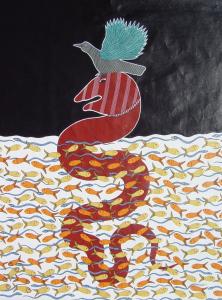| “Kaag Bhusund Alights on Nag Devita’’ (2007) by Bhajju Shyam, from the exhibit of contemporary Pardhan Gond art. WELLESLEY — “Painted Songs & Stories: Contemporary Pardhan Gond Art From India,’’ a sparkling show at the Davis Museum and Cultural Center at Wellesley College, marks the first American exhibition highlighting the art of the Gond peoples of central India. Vibrating with brilliantly patterned mythological imagery, the exhibit also touches on familiar questions about the commercialization of indigenous art. Discuss COMMENTS (0) PAINTED SONGS & STORIES: Contemporary Pardhan Gond Art From India SEEING GOD IN PRINTS: Indian Lithographs From the Collection of Mark Baron and Elise Boisanté At: Davis Museum and Cultural Center, Wellesley College, Wellesley, through June 6. 781-283-2051, www.davismuseum.wellesley.edu Members of the Pardhan clan have been the storytellers, bards, and keepers of the mythology of the Gonds. Their tradition was an oral one. Indeed, the Gonds’ supreme deity is embodied by a musical instrument, a three-stringed affair depicted in the spritely painting “The Bana as Bara Deo,’’ by Rajendra Shyam. With snakes slithering across its frets and speckled birds roosting on either side, the instrument has an orange face with strong almond eyes and slightly bared teeth. The imagery in “Painted Songs & Stories’’ carries the potent charge of long told tales, but it’s only in the last 30 years that the Pardhan Gonds have picked up brushes and pigments, bringing narrative painting to the forefront of their expressive repertoire. Jangarh Singh Shyam was the patriarch of the clan’s artists. He was discovered by governmental scouts seeking talented tribal artists in 1981. Shyam, then 21, had dabbled in sculptures and murals, but he was making a subsistence living hauling dirt. The scouts liked his work and moved him to the big city, Bhopal, where they gave him a job and housing and launched his career. His art became wildly popular, and he developed an international following. Look at Shyam’s “Scorpion,’’ a dancing ink and watercolor piece. Hypnotically patterned sections make up the insect’s body. Lightning-rod zigzags in ink surround the scorpion’s legs. Its body glows with warm orange and pink washes and is surrounded by a rosy halo, textured by the artist’s trademark speckles. Pardhan Gonds consider the scorpion a sign of luck, and Shyam imbues this one with mesmerizing power. Family joined him, and he painted to support a small art colony under his own roof, encouraging other Pardhans to translate their stories into images. But in 2001, Shyam committed suicide in a Japanese museum where he was artist-in-residence. In the exhibition’s catalog essay, curator John H. Bowles quotes a friend of Shyam’s suggesting that the artist’s workload and family pressures, as well as city life, weighed on him. The artist’s nephew, Bhajju Shyam, has, like his uncle, garnered international attention. His “Kaag Bhusund Alights on Nag Devita’’ snaps against a bold black-and-white background: black sky, white sea, swarming with small fish and eels. Nag Devita, a snake god, writhes up from below and sneers in horror as Kaag Bhusund, a crow known as the Black One, mistakes his head for a place to land. The image pops with intricate patterning, undulating movement, and glowing contours.Continued... |
Tuesday, May 25, 2010
Another art of the storyteller
India’s deities and legends radiate in Wellesley exhibits
Subscribe to:
Post Comments (Atom)

No comments:
Post a Comment